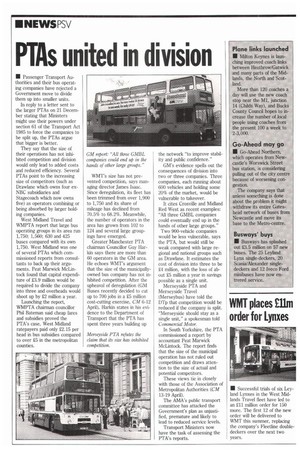PTAs united in division
Page 20

If you've noticed an error in this article please click here to report it so we can fix it.
• Passenger Transport Authorities and their bus operating companies have rejected a Government move to divide them up into smaller units.
In reply to a letter sent to the larger PTAs on 21 December stating that Ministers might use their powers under section 61 of the Transport Act 1985 to force the companies to be split up, the PTAs argue that bigger is better.
They say that the size of their operations has not inhibited competition and division would only lead to added costs and reduced efficiency. Several PTAs point to the increasing size of competitors (such as Drawlane which owns four exNBC subsidiaries and Stagecoach which now owns five) as operators combining or being absorbed by larger holding companies.
West Midland Travel and WMPTA report that large bus operating groups in its area run 1,750; 1,560; 630 and 425 buses compared with its own 1,750. West Midland was one of several PTAs which commissioned reports from consultants to back up their arguments. Peat Marwick McLintock found that capital expenditure of £3.9 million would be required to divide the company into three and overheads would shoot up by 22 million a year.
Launching the report, WMPTA chairman councillor Phil Bateman said cheap fares and subsidies proved the PTA's case, West Midland ratepayers paid only 22.15 per head in bus subsidies compared to over 25 in the metropolitan counties. WMT's size has not prevented competition, says managing director James Isaac. Since deregulation, its fleet has been trimmed from over 1,900 to 1,750 and its share of mileage has declined from 70.5% to 68.2%. Meanwhile, the number of operators in the area has grown from 102 to 124 and several large groupings have emerged.
Greater Manchester PTA chairman Councillor Guy Harkin says there are more than 60 operators in the GM area. He echoes WMT's argument that the size of the municipallyowned bus company has not inhibited competition. After the upheaval of deregulation (GM Buses recently decided to cut up to 700 jobs in a 25 million cost-cutting exercise, CM 6-12 April), Harkin states in his evidence to the Department of Transport that the PTA has spent three years building up the network "to improve stability and public confidence."
GM's evidence spells out the consequences of division into two or three companies. Three companies, each running about 600 vehicles and holding some 20% of the market, would be vulnerable to takeover.
It cites Crosville and Midland Red West as recent examples: "All three GMBL companies could eventually end up in the hands of other large groups." Two 900-vehicle companies would be less vulnerable, says the PTA, but would still be weak compared with large regional and national groups such as Drawlane. It estimates the cost of division into three to be £4 million, with the loss of about £5 million a year in savings possible as a single unit.
Merseyside PTA and Merseyside Travel (Merseybus) have told the DTp that competition would be reduced if the company is split. "Merseyside should stay as a single unit," a spokesman told Commercial Motor.
In South Yorkshire, the PTA commissioned a report by accountant Peat Marwick McLintock. The report finds that the size of the municipal operation has not ruled out competition and draws attention to the size of actual and potential competitors.
These views tie in closely with those of the Association of Metropolitan Authorities (CM 13-19 April).
The AMA's public transport committee has attacked the Government's plan as unjustified, premature and likely to lead to reduced service levels.
Transport Ministers now have the task of assessing the PTA's reports.




















































































































































